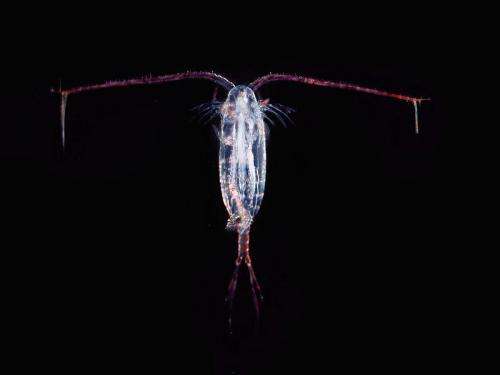Copepod. Credit: Uwe Kils/Wikipedia
We all know the amazing job that bees and birds, as pollinators, do for the planet. But have you heard about the humble copepod?
Tiny but vital
Copepods can be as small as the tip of a needle and have been compared to wildebeest that roam the plains of Africa. Like wildebeest, these crustaceans travel great distances, sinking over 1km to spend winter sleeping after fattening up in spring. Copepods also play a vital role in circulating carbon between living organisms and their surroundings. They get omega-3 fatty acids from eating microscopic plants in the sea that have absorbed carbon through photosynthesis, which travels into the deep sea via sinking copepod poo, stopping it from returning to the atmosphere as carbon dioxide.
It's clear they're important, but we don't know how Arctic ice retreat and climate change affects these shrimp-like creatures. Will the warming poles change where they go, what they eat, how they behave, grow and reproduce? These questions inspired Holly Jenkins, Ph.D. student at the University of Southampton, to journey across the Fram Strait—the passage between Greenland and Svalbard—with 25 fellow scientists.
The changing Arctic Ocean
Holly works on the DIAPOD project, funded by NERC as part of the Changing Arctic Ocean programme, which aims to understand the impacts of climate change on Arctic ecosystems and their global consequences.
As work environments go, the Arctic Ocean is breathtaking. It's not every day that you look out of the window to be greeted by a pod of common dolphins. Holly recalls: "They put on an amazing show, leaping out of the ocean and chasing the birds that were sat in our wake. It's a sight I'll never forget."
Beyond its beauty, the Arctic is crucial for many reasons. It supports diverse marine life and helps to keep our world's climate in balance. There has already been an average global temperature increase of 1°C above pre-industrial levels, and we are now heading for 3°C warming by the end of the century. This would leave the Arctic ice-free every summer.
As well as the global impacts, these changes are altering how the Arctic ecosystem works. As Arctic sea ice retreats and thins, it reflects less light and heat, which are instead absorbed by the ocean. This exaggerates the temperature differences between the surface water and the colder deep, limiting the upwards mixing of nutrient-rich waters with the surface. The marine plants that thrive in these conditions have a different nutritional make-up to the 'usual suspects', so we need to find out how these changes affect the copepods themselves.
Holly said: "In the past, we thought that how copepods grow and reproduce was controlled by how much food they can access, but it's not this simple. We still don't know exactly what they need to thrive, but if we find this out, we can make future projections about how successful they will be and how this will affect the food chain and the whole ecosystem."
Catch, sample, repeat
Holly's part in this took her to a cold lab on board the RRS James Clark Ross, where she spent five weeks catching hundreds of copepods and incubating them on a slowly moving wheel to measure what they eat, how much they eat, and how that changes across the Arctic. Her routine was simple: catch the copepods in a plankton net, gently pluck them from the mesh with tweezers, and put them into sampling bottles with seawater and its tasty plants. Next day, more of the same: move them into new bottles, sample the old bottles to identify what has been eaten, and count the eggs that have been spawned (12,590 in total).
Holly then tested whether there was a relationship between the number of eggs and the quantity and quality of food in the bottles, when coupled with some further lab work to analyse the composition of what she had collected. She said: "In time this will allow me to understand the effect that diet is having on them. It is fiddly work in such cold temperatures, but it's the best way to find the answers we need."
If Holly finds out what the copepods need to thrive, the DIAPOD project can predict how successful these little creatures will be, and how this will affect the food chain. And how this will affect the whole Arctic ecosystem.
Back at sea
Holly would be forgiven for vowing never to set eyes on another plankton net, test tube or set of tweezers. But she is gearing up for another Arctic stint in August this year, when she will do it all again—all in the name of science.
Provided by PlanetEarth Online
This story is republished courtesy of Planet Earth online, a free, companion website to the award-winning magazine Planet Earth published and funded by the Natural Environment Research Council (NERC).
























